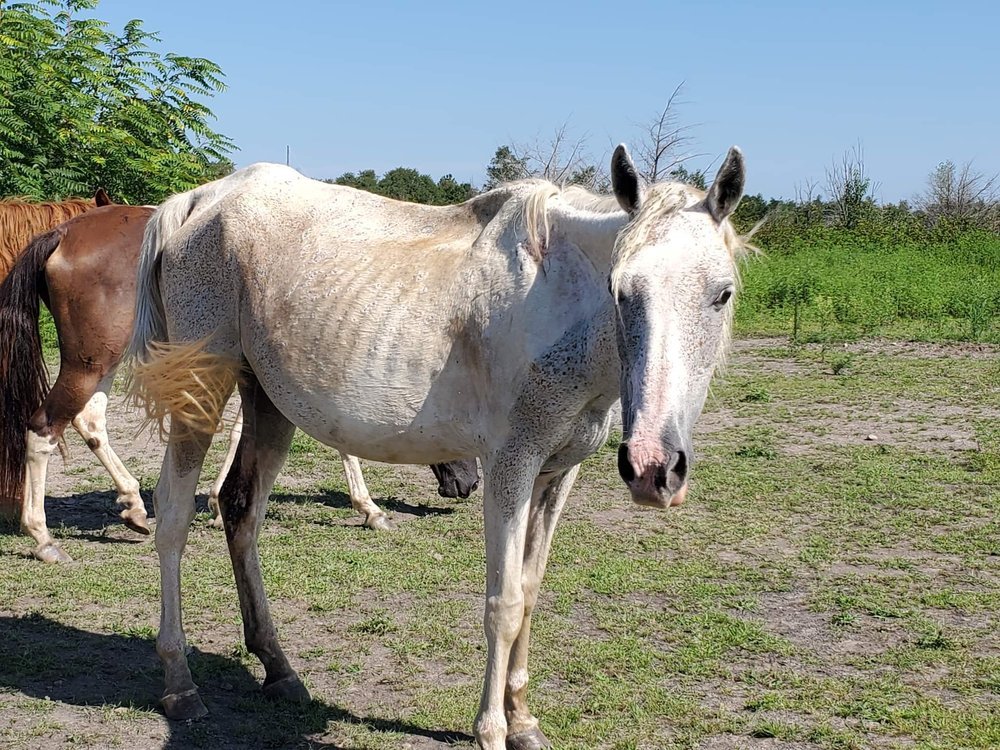One of our most important goals is to provide herd management and equine welfare activities. Herd management means that we will work to ensure that herds are healthy, well-fed, and that any injuries are attended to.
In addition, herd management includes population control. Currently, there are stallions breeding bands of mares each year, increasing their herd sizes at a rate that is not sustainable. Stallions with a herd of mares can double the herd size in four years. An additional concern is that the mares who are bred each year have difficulty keeping on weight, as they are often pregnant while still nursing last year’s foal. The Appalachian Horse Project will work with other equine welfare agencies on gelding operations as needed to keep herds at manageable sizes.
A New Approach For Better Outcomes
The following information is written with intent to help everyone understand the challenges we face when dealing with free roaming horse rescues, especially the malnourished feral mares, and what we’ve learned and how we can change our mindset and processes in order to gain a better outcome for these mares and their foals.
The story begins with a couple mares – 6 year old Kabuki and 18 year old Dove. Both feral mares in very poor body condition – both born on the mountain, both never really handled, never haltered, never trailered or kept in a barn. Completely untouchable and unapproachable, Dove wouldn’t even eat feed from a bucket, therefore we could not dewormed her. In fact, she had to be sedated by a veterinarian just to catch and load. She had lost this year’s foal earlier in the spring and her body condition seemed to be improving at first, but with winter coming on we felt her chances of survival were slim, and therefore with ACO permission she was removed in September. Within 3 days she gave up.
Kabuki, although much younger and more approachable than Dove, was picked in late August along with her 5 month old colt. She obviously needed more nutrition than what she had been getting as her foal was literally sucking the life out of her. She had already been dewormed twice this season but still not gaining weight. The call was made to remove her and wean the colt. She seemed to tolerate people, her new surroundings and was eating hay but within days she just seemed to give up and slipped away. The only good news here is that her colt is doing great and was adopted by his foster family.
Losing two mares within a month made us take a step back, ask ourselves a lot of questions and rethink how we rescue future malnourished mares. Losing one is always hard – but two within a short timeframe was really difficult. It seems like a catch-22 situation - If we remove her and she dies what have we accomplished? If we leave her and she doesn’t make it, we haven’t done our job…
So the question loomed large - how can we improve the chances for the next mare who needs help? After much discussion and recommendations from our veterinarian team and with the permission of the local ACO, we will now closely evaluate each individual mare and make a decision based on several factors of what would be best for each particular horse. Leaving the mare with her herd and only removing the foals (old enough to wean) and any yearlings still nursing may be the best option for both mares and foals. This would give the mares a better chance of re-gaining weight and the foals would receive proper health care at an earlier age.
Some thoughts behind this decision -
• Free roaming mares are bred every year while pregnant and nursing a foal, and in some cases their yearling is still nursing. This takes A LOT of nutrition away from the mare and it is very hard to maintain body weight with just one foal much less two.
• Mares who wean their foals have a much better chance than those nursing both a foal and a yearling
• Most unhandled adult horses (more feral i.e born on the mountain) do not do well in captivity
• Catching, loading, hauling adds more stress to the feral horse
• Stress is hard on any horse but much worse on those in poor condition
• Yearlings and weanlings adapt quickly to people and new surroundings
• Young horses have a better chance at a healthy life and are more trainable and adoptable
Present day –
Two mares were identified last week with poor body condition – Bella and Autumn, both born on the mountain.
Bella was very thin after her 2019 foal but maintained enough weight with a little extra feed and regular deworming by volunteers to remain. She didn’t have a 2020 foal and she gained and maintained a healthy weight until this year, which tells us that there was a direct correlation between her previous weight loss and nursing without added nutrition. She is once again in poor shape -and we know it’s not due to teeth problems, parasite problems nor feet problems….but that she is nursing her 2022 foal and her 2021 yearling.
Autumn has a similar story - According to our documentation, she had her first foal in 2020. She was in good shape, however the foal didn’t survive as we realized too late that she didn’t have enough milk. Since she didn’t have a 2021 foal, she has been able to maintain her weight until now. Her 2022 foal was born in April and even though she seems to have milk, he is very small and is literally sucking the life out of her.
Therefore the decision was made to remove the foals and the yearling off these two mares giving them all the best possible chance of a healthy outcome.
We will keep you posted on the condition of them all.







